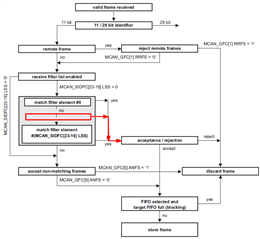Tool/software:
Hello,
I'm performing a test on an AM36x SItara processor using a single CAN bus, aiming to receive both standard and extended ID can messages. However, I'm facing an issue where the reception behavior seems to depend on the order in which I add the filters.
For example, when I add filters in the order < standard_id_0 , standard_id_1, extended_id_0, extended_id_1, standard_id_2 >, only messages with standard_id_1 and standard_id_2 are received.
On the other hand, when I add them in the order < extended_id_0, extended_id_1, standard_id_0, standard_id_1 >, only messages with extended_id_0 are NOT received.
Could you clarify:
- How does the filter order affect message reception?
- Is there any recommended way to configure filters to ensure both standard and extended IDs are received correctly using Classic Filter?
- Should filters be applied in a specific sequence to avoid inconsistent behavior of reception?
Thanks in advance for your support!


